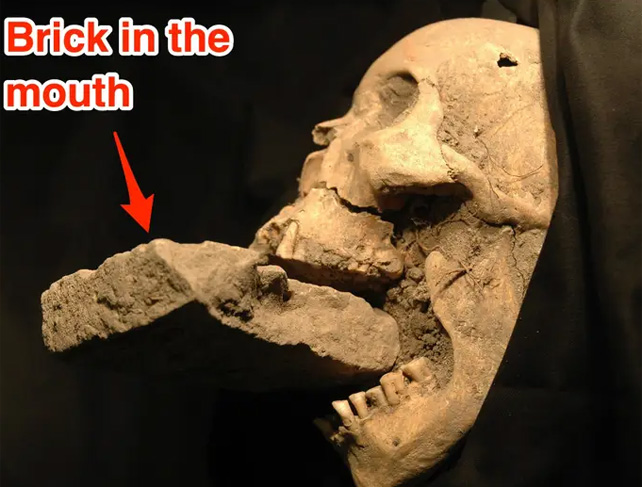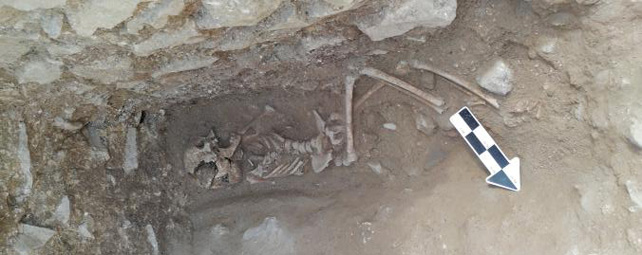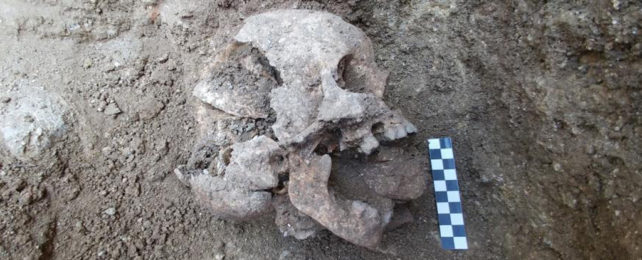Archeologists recently uncovered an example of a "vampire" burial in Poland with a sickle around the body's neck to keep it from rising from the grave.
But there are other ways humans prevented the undead "vampires" from tormenting the living, one of which was placing a rock or brick in their mouth, experts told Insider.
Here are two examples of such burials uncovered by archeologists and what they mean according to experts.
A stone to stop the Nachzehrer "vampire"
In this case, a woman's body was uncovered in a 16th-century grave in Lazzaretto Nuovo, about 2 miles from Venice, Italy.
The woman, nicknamed "Carmilla" by the scientists who uncovered her, was found with a brick in her mouth inside a mass grave, a bizarre ritual unlike other burials at the time.
Not much is known about her identity in life, but archeologists know she died during a deadly outbreak of bubonic plague.
"I had to find an explanation for someone actually manipulating the body of a person with a deadly disease," Matteo Borrini, principal lecturer of forensic anthropology at the Liverpool John Moore University, told Insider.

Borrini was the lead scientist on the dig. He conducted a careful forensic examination to understand what happened.
He discovered the woman was probably thought to be a Nachzehrer, a type of vampire in old European folklore.
"It's not the classical idea that the vampire is going out and sucking the blood of people. It's more someone that is killing people from the grave before being able to then rise as a full vampire," he said.
"What I found was that there was this tradition that said there were bodies people believed were responsible for spreading the plague around. These bodies were not completely dead and were captured by some demonic influence," said Borrini, describing the old beliefs.
"And they were chewing their shroud inside their graves and spreading the plague in a sort of black magical way," he said.
Placing a brick in her mouth would, per these beliefs, keep the Nachzehrer from chewing their way out, and so protect the living from the disease.
Carmilla wouldn't have been considered a vampire during her lifetime, however. Borrini's work showed that the mass grave was reopened after Carmilla was buried. At that point, her body, which was still wrapped in a shroud, was likely not completely decomposed.
Grave diggers, confronted with this body seemingly still fresh with the shroud decomposed around the mouth, may have assumed the body was possessed and placed the brick there.
A stone to keep the soul from spreading disease
Researchers at the University of Arizona and Stanford University found another example of a "vampire." This one was buried in a child cemetery on the site of the Poggio Gramignano ancient Roman villa in Teverina, Italy.
The child, who was about 10 years old, was buried in the 5th century during a deadly outbreak of malaria. A stone was also placed in the child's mouth.
Jordan Wilson, the lead bioarchaeologist for the Villa Romana di Poggio Gramignano archeological project, told Insider the stone was likely there to keep the child's soul from coming in or out of the body.

"There's a very ancient idea of breath being linked to life and the soul, and the mouth in particular as being sort of the portal through which the soul exits after death," she said.
The stone may have been a way to keep the child's body or spirit from spreading the disease or generally tormenting the living. It may also have been a way to keep the child safe from witches, which were thought to be able to raise children from the dead and use their souls.
Vampires as vectors for disease
"Vampire" myths have been accompanying the death of humans for centuries.
They were ways to understand what couldn't be explained with the knowledge of the time, such as mysterious deaths during a contagious outbreak, Borrini said.
"These 'vampires' start to hunt and kill family members first, then the neighbors, and then all the other village. This is the classical pattern of a disease that is contagious," he said.
Borrini defines a "vampire" as a dead person rising from the dead as a body.
Wilson, however, said any myth where a dead person can torment the living, either via their spirit or their reanimated body, is part of the "vampire" folklore.
"The idea the dead can either rise from the grave in a literal sense or that the dead, in a spiritual sense, can continue to plague the living beyond death is something that's essentially present in almost every culture and has very, very ancient origins," she said.
This article was originally published by Business Insider.
More from Business Insider: